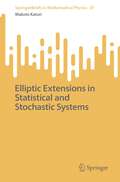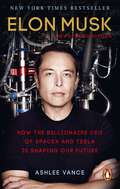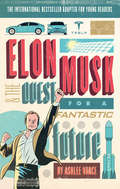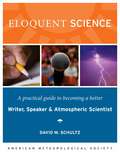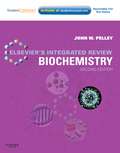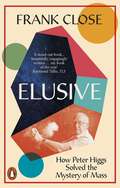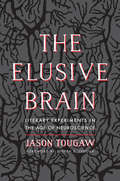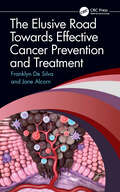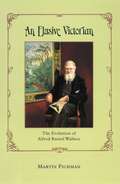- Table View
- List View
Elliptic Carleman Estimates and Applications to Stabilization and Controllability, Volume I: Dirichlet Boundary Conditions on Euclidean Space (Progress in Nonlinear Differential Equations and Their Applications #97)
by Jérôme Le Rousseau Gilles Lebeau Luc RobbianoThis monograph explores applications of Carleman estimates in the study of stabilization and controllability properties of partial differential equations, including the stabilization property of the damped wave equation and the null-controllability of the heat equation. All analysis is performed in the case of open sets in the Euclidean space; a second volume will extend this treatment to Riemannian manifolds.The first three chapters illustrate the derivation of Carleman estimates using pseudo-differential calculus with a large parameter. Continuation issues are then addressed, followed by a proof of the logarithmic stabilization of the damped wave equation by means of two alternative proofs of the resolvent estimate for the generator of a damped wave semigroup. The authors then discuss null-controllability of the heat equation, its equivalence with observability, and how the spectral inequality allows one to either construct a control function or prove the observability inequality. The final part of the book is devoted to the exposition of some necessary background material: the theory of distributions, invariance under change of variables, elliptic operators with Dirichlet data and associated semigroup, and some elements from functional analysis and semigroup theory.
Elliptic Carleman Estimates and Applications to Stabilization and Controllability, Volume II: General Boundary Conditions on Riemannian Manifolds (Progress in Nonlinear Differential Equations and Their Applications #98)
by Jérôme Le Rousseau Gilles Lebeau Luc RobbianoThis monograph explores applications of Carleman estimates in the study of stabilization and controllability properties of partial differential equations, including quantified unique continuation, logarithmic stabilization of the wave equation, and null-controllability of the heat equation. Where the first volume derived these estimates in regular open sets in Euclidean space and Dirichlet boundary conditions, here they are extended to Riemannian manifolds and more general boundary conditions.The book begins with the study of Lopatinskii-Sapiro boundary conditions for the Laplace-Beltrami operator, followed by derivation of Carleman estimates for this operator on Riemannian manifolds. Applications of Carleman estimates are explored next: quantified unique continuation issues, a proof of the logarithmic stabilization of the boundary-damped wave equation, and a spectral inequality with general boundary conditions to derive the null-controllability result for the heat equation. Two additional chapters consider some more advanced results on Carleman estimates. The final part of the book is devoted to exposition of some necessary background material: elements of differential and Riemannian geometry, and Sobolev spaces and Laplace problems on Riemannian manifolds.
Elliptic Differential Equations: Theory and Numerical Treatment (Springer Series in Computational Mathematics #18)
by Wolfgang HackbuschThis book simultaneously presents the theory and the numerical treatment of elliptic boundary value problems, since an understanding of the theory is necessary for the numerical analysis of the discretisation. It first discusses the Laplace equation and its finite difference discretisation before addressing the general linear differential equation of second order. The variational formulation together with the necessary background from functional analysis provides the basis for the Galerkin and finite-element methods, which are explored in detail. A more advanced chapter leads the reader to the theory of regularity. Individual chapters are devoted to singularly perturbed as well as to elliptic eigenvalue problems. The book also presents the Stokes problem and its discretisation as an example of a saddle-point problem taking into account its relevance to applications in fluid dynamics.
Elliptic Extensions in Statistical and Stochastic Systems (SpringerBriefs in Mathematical Physics #47)
by Makoto KatoriHermite's theorem makes it known that there are three levels of mathematical frames in which a simple addition formula is valid. They are rational, q-analogue, and elliptic-analogue. Based on the addition formula and associated mathematical structures, productive studies have been carried out in the process of q-extension of the rational (classical) formulas in enumerative combinatorics, theory of special functions, representation theory, study of integrable systems, and so on. Originating from the paper by Date, Jimbo, Kuniba, Miwa, and Okado on the exactly solvable statistical mechanics models using the theta function identities (1987), the formulas obtained at the q-level are now extended to the elliptic level in many research fields in mathematics and theoretical physics. In the present monograph, the recent progress of the elliptic extensions in the study of statistical and stochastic models in equilibrium and nonequilibrium statistical mechanics and probability theory is shown. At the elliptic level, many special functions are used, including Jacobi's theta functions, Weierstrass elliptic functions, Jacobi's elliptic functions, and others. This monograph is not intended to be a handbook of mathematical formulas of these elliptic functions, however. Thus, use is made only of the theta function of a complex-valued argument and a real-valued nome, which is a simplified version of the four kinds of Jacobi's theta functions. Then, the seven systems of orthogonal theta functions, written using a polynomial of the argument multiplied by a single theta function, or pairs of such functions, can be defined. They were introduced by Rosengren and Schlosser (2006), in association with the seven irreducible reduced affine root systems. Using Rosengren and Schlosser's theta functions, non-colliding Brownian bridges on a one-dimensional torus and an interval are discussed, along with determinantal point processes on a two-dimensional torus. Their scaling limits are argued, and the infinite particle systems are derived. Such limit transitions will be regarded as the mathematical realizations of the thermodynamic or hydrodynamic limits that are central subjects of statistical mechanics.
Elliptische Differentialgleichungen zweiter Ordnung: Eine Einführung mit historischen Bemerkungen (Masterclass)
by Ernst Wienholtz Hubert Kalf Thomas KriecherbauerAusgehend von der Mittelwerteigenschaft harmonischer Funktionen über die Perronsche Methode zur Lösung des Dirichletproblems für die Laplace-Gleichung sowie den Kelloggschen Satz über das Randverhalten von Lösungen der Poisson-Gleichung stellen die Autoren stufenweise die klassische Theorie linearer elliptischer Differentialgleichungen 2. Ordnung dar. Dabei präsentieren sie neue Beweise, so für die Symmetrie und die Abschätzung der Greenschen Funktion. Eine Besonderheit dieses Buches sind ferner die vielen historischen Bezüge und Literaturverweise.
The Elms: Breeding, Conservation, and Disease Management
by Christopher P. DunnElms occur, both naturally and cultivated, throughout much of the temperate world. Because of their high tolerance to extreme growing conditions and their widespread distribution, elms have been widely planted in cities, towns and rural areas throughout North America and northern Europe. As such, their current demise due to several pandemics of Dutch elm disease has spurred a huge body of research on breeding for disease resistance, conservation and systematics. The Elms: Breeding, Conservation and Disease Management provides the current state of knowledge in these areas and is an important reference work for pathologists, breeders, taxonomists, and arborists.
Elon Musk: How the Billionaire CEO of SpaceX and Tesla is Shaping our Future
by Ashlee VanceSouth African born Elon Musk is the renowned entrepreneur and innovator behind PayPal, SpaceX, Tesla, and SolarCity. Musk wants to save our planet; he wants to send citizens into space, to form a colony on Mars; he wants to make money while doing these things; and he wants us all to know about it. He is the real-life inspiration for the Iron Man series of films starring Robert Downey Junior.The personal tale of Musk’s life comes with all the trappings one associates with a great, drama-filled story. He was a freakishly bright kid who was bullied brutally at school, and abused by his father. In the midst of these rough conditions, and the violence of apartheid South Africa, Musk still thrived academically and attended the University of Pennsylvania, where he paid his own way through school by turning his house into a club and throwing massive parties.He started a pair of huge dot-com successes, including PayPal, which eBay acquired for $1.5 billion in 2002. Musk was forced out as CEO and so began his lost years in which he decided to go it alone and baffled friends by investing his fortune in rockets and electric cars. Meanwhile Musk’s marriage disintegrated as his technological obsessions took over his life ...Elon Musk is the Steve Jobs of the present and the future, and for the past twelve months, he has been shadowed by tech reporter, Ashlee Vance. Elon Musk: How the Billionaire CEO of Spacex and Tesla is Shaping our Future is an important, exciting and intelligent account of the real-life Iron Man.
Elon Musk Young Readers’ Edition: Tesla, Spacex, And The Quest For A Fantastic Future
by Ashlee VanceElon Musk is an inspirational role model for young entrepreneurs, breaking boundaries and revolutionising the tech-world. He is also the real-life inspiration for the Iron Man series of films, starring Robert Downey Junior. From his humble beginnings in apartheid South Africa, he showed himself to be an exceptionally bright child, and overcame brutal bullying to become the world’s most exciting entrepreneur, founding PayPal, SpaceX, Tesla and Solar City.He has emerged as something of a superhero-like figure for today’s generation of children. He’s not only seen as an entrepreneur in the spirit of a Steve Jobs but as an inventor and bold thinker. He’s the guy offering children the possibility of a brighter, more exciting future and has come to symbolize innovation and optimism.
Eloquent Science: A Practical Guide to Becoming a Better Writer, Speaker, and Atmospheric Scientist
by David SchultzMary Grace Soccio. My writing could not please this kindhearted woman, no matter how hard I tried. Although Gifed and Talented seventh-grade math posed no problem for me, the same was not true for Mrs. Soccio’s English class. I was frustrated that my frst assignment only netted me a C. I worked harder, making re- sion afer revision, a concept I had never really put much faith in before. At last, I produced an essay that seemed the apex of what I was capable of wr- ing. Although the topic of that essay is now lost to my memory, the grade I received was not: a B?. “Te best I could do was a B??” Te realization sank in that maybe I was not such a good writer. In those days, my youthful hubris did not understand abouc t apacity bui- ing. In other words, being challenged would result in my intellectual growth— an academic restatement of Nietzsche’s “What does not destroy me, makes me stronger.” Consequently, I asked to be withdrawn from Gifed and Talented English in the eighth grade.
Elsevier’s Encyclopaedia of Organic Chemistry: Series III: Carboisocyclic Condensed Compounds (Elsevier's Encyclopaedia of Organic Chemistry)
by Edith Josephy F. RadtWhen, a few years ago, the publication of Elsevier's Encyclo pa:dia of Organic Chemistry was suspended, it seemed desirable to complete-on account of its monographic character-the steroid section in accordance with the original conception. One conside ration in favour thereof, among others, was that the steroid section of Beilstein's Handbuch will not be available for some years to come, so that also to those using Beilstein the present publication is a valuable help in bridging the gap. In view of the undiminished activity in this special field- equally important to chemists, bio chemists, and the medical world - the hope that the completion of this section will meet the needs of a wide circle of readers ap pears tobe justified. Altogether three more volumes are planned for the Supplement, the first of which, now presented, covers the steroid Oxo-com pounds, the Iiterature having been consulted up to the end of 1946 in conformity with the previous volumes of the steroid Supplement. Where, however, important additions and correc tions are concerned, Iiterature up to the most recent date has been taken into account. In treating the subject matter the same prin ciples have been followed as in the previous volumes of this section. Editorship remains in the competent hands of Dr. F. RADT, who has contributed a considerable proportion of the matter treated in this volume. He is assisted by Dr. A. GEORG and Dr. DoRA STERN.
Elsevier's Integrated Review Biochemistry E-Book: with STUDENT CONSULT Online Access (Elsevier's Integrated)
by John W. PelleyEffectively merge basic science and clinical skills with Elsevier's Integrated Review Biochemistry, by John W. Pelley, PhD. This concise, high-yield title in the popular Integrated Review Series focuses on the core knowledge in biochemistry while linking that information to related concepts from other basic science disciplines. Case-based questions at the end of each chapter enable you to gauge your mastery of the material, and a color-coded format allows you to quickly find the specific guidance you need. This concise and user-friendly reference provides crucial guidance for the early years of medical training and USMLE preparation.This title includes additional digital media when purchased in print format. For this digital book edition, media content is not included. Spend more time reviewing and less time searching thanks to an extremely focused, "high-yield" presentation. Gauge your mastery of the material and build confidence with both case-based, andUSMLE-style questions that provide effective chapter review and quick practice for your exams. This title includes additional digital media when purchased in print format. For this digital book edition, media content is not included. Grasp and retain vital concepts more easily thanks to a color-coded format, succinct,text, key concept boxes, and dynamic illustrations that facilitate learning in a highly visual approach. Effectively review for problem-based courses with the help of text boxes that help you clearly see the clinical relevance of the material.
Elucidation of Abiotic Stress Signaling in Plants: Functional Genomics Perspectives, Volume 1
by Girdhar K. PandeyAbiotic stresses such as high temperature, low-temperature, drought, and salinity limit crop productivity worldwide. Understanding plant responses to these stresses is essential for rational engineering of crop plants. In Arabidopsis, the signal transduction pathways for abiotic stresses, light, several phytohormones and pathogenesis have been elucidated. A significant portion of plant genomes (most studies are Arabidopsis and rice genome) encodes for proteins involves in signaling such as receptor, sensors, kinases, phosphatases, transcription factors and transporters/channels. Despite decades of physiological and molecular effort, knowledge pertaining to how plants sense and transduce low and high temperature, low-water availability (drought), water-submergence and salinity signals is still a major question before plant biologists. One major constraint hampering our understanding of these signal transduction processes in plants has been the lack or slow pace of application of molecular genomic and genetics knowledge in the form of gene function. In the post-genomic era, one of the major challenges is investigation and understanding of multiple genes and gene families regulating a particular physiological and developmental aspect of plant life cycle. One of the important physiological processes is regulation of stress response, which leads to adaptation or adjustment in response to adverse stimuli. With the holistic understanding of the signaling pathways involving not only one gene family but multiple genes or gene families, plant biologists can lay a foundation for designing and generating future crops that can withstand the higher degree of environmental stresses (especially abiotic stresses, which are the major cause of crop loss throughout the world) without losing crop yield and productivity.
Elucidation of Abiotic Stress Signaling in Plants: Functional Genomics Perspectives, Volume 2
by Girdhar K. PandeyAbiotic stresses such as high temperature, low-temperature, drought, and salinity limit crop productivity worldwide. Understanding plant responses to these stresses is essential for rational engineering of crop plants. In Arabidopsis, the signal transduction pathways for abiotic stresses, light, several phytohormones and pathogenesis have been elucidated. A significant portion of plant genomes (most studies are Arabidopsis and rice genome) encodes for proteins involves in signaling such as receptor, sensors, kinases, phosphatases, transcription factors and transporters/channels. Despite decades of physiological and molecular effort, knowledge pertaining to how plants sense and transduce low and high temperature, low-water availability (drought), water-submergence and salinity signals is still a major question before plant biologists. One major constraint hampering our understanding of these signal transduction processes in plants has been the lack or slow pace of application of molecular genomic and genetics knowledge in the form of gene function. In the post-genomic era, one of the major challenges is investigation and understanding of multiple genes and gene families regulating a particular physiological and developmental aspect of plant life cycle. One of the important physiological processes is regulation of stress response, which leads to adaptation or adjustment in response to adverse stimuli. With the holistic understanding of the signaling pathways involving not only one gene family but multiple genes or gene families, plant biologists can lay a foundation for designing and generating future crops that can withstand the higher degree of environmental stresses (especially abiotic stresses, which are the major cause of crop loss throughout the world) without losing crop yield and productivity. Therefore, in this proposed book, we intend to incorporate the contribution from leading plant biologists to elucidate several aspects of stress signaling by functional genomic approaches.
Elusive: How Peter Higgs Solved the Mystery of Mass
by Frank CloseThe story of the Higgs boson - the so-called 'God particle' - and the man who thought of itIn the summer of 1964, a reclusive young professor at the University of Edinburgh wrote two scientific papers which have come to change our understanding of the most fundamental building blocks of matter and the nature of the universe. Peter Higgs posited the existence an almost infinitely tiny particle - today known as the Higgs boson - which is the key to understanding why particles have mass, and but for which atoms and molecules could not exist.For nearly 50 years afterwards, some of the largest projects in experimental physics sought to demonstrate the physical existence of the boson which Higgs had proposed. Sensationally, confirmation came in July 2012 at the Large Hadron Collider at CERN in Geneva. The following year Higgs was awarded the Nobel Prize for Physics. One of the least-known giants of science, he is the only person in history to have had a single particle named for them.This revelatory book is 'not so much a biography of the man but of the boson named after him'. It brilliantly traces the course of much of twentieth-century physics from the inception of quantum field theory to the completion of the 'standard model' of particles and forces, and the pivotal role of Higgs's idea in this evolution. It also investigates the contested history of Higgs's responsibility for the breakthrough when there were others close by, and explains why the boson is named for him alone. Competition between institutions and states, Close shows, then played as much of a role in creating Higgs's fame as his work itself. Drawing on conversations with Higgs over a decade (a figure generally as elusive as his particle) this is a superb study of a scientist and his era - and of how scientific knowledge advances.
The Elusive Brain: Literary Experiments in the Age of Neuroscience
by Jason TougawFeaturing a foreword by renowned neuroscientist Joseph E. LeDoux, The Elusive Brain is an illuminating, comprehensive survey of contemporary literature’s engagement with neuroscience. This fascinating book explores how literature interacts with neuroscience to provide a better understanding of the brain’s relationship to the self. Jason Tougaw surveys the work of contemporary writers—including Oliver Sacks, Temple Grandin, Richard Powers, Siri Hustvedt, and Tito Rajarshi Mukhopadhyay—analyzing the way they experiment with literary forms to frame new views of the immaterial experiences that compose a self. He argues that their work offers a necessary counterbalance to a wider cultural neuromania that seeks out purely neural explanations for human behaviors as varied as reading, economics, empathy, and racism. Building on recent scholarship, Tougaw’s evenhanded account will be an original contribution to the growing field of neuroscience and literature.
The Elusive Road Towards Effective Cancer Prevention and Treatment
by Franklyn De Silva Jane AlcornCancer will remain a global major health problem unless new diagnostic, prognostic, and management approaches are discovered to address both loss of life and quality of life. Here we summarize the general physiology, pathology, heterogeneity, and evolution of cancer, current status, limitations and challenges associated with prevention, incidence, treatment, survival, and mortality, as well as future directions with regards to solid tumors. Perspectives are provided on how to improve pre-clinical understandings, outcomes, and patient care. Further, this comprehensive, timely overview of the literature has educational value as part of an academic course, seminar, or as a supplementary text.
The Elusive Road Towards Effective Cancer Prevention and Treatment
by Franklyn De Silva Jane AlcornCancer will remain a global major health problem unless new diagnostic, prognostic, and management approaches are discovered to address both loss of life and quality of life. Here we summarize the general physiology, pathology, heterogeneity, and evolution of cancer, current status, limitations and challenges associated with prevention, incidence, treatment, survival, and mortality, as well as future directions with regards to solid tumors. Perspectives are provided on how to improve pre-clinical understandings, outcomes, and patient care. Further, this comprehensive, timely overview of the literature has educational value as part of an academic course, seminar, or as a supplementary text.
The Elusive Synthesis: Aesthetics and Science (Boston Studies in the Philosophy and History of Science #182)
by Alfred I. TauberThe tension between art and science may be traced back to the Greeks. What became "natural philosophy" and later "science" has traditionally been posed as a fundamental alternative to poetry and art. It is a theme that has commanded central attention in Western thought, as it captures the ancient conflict of Apollo and Dionysus over what deserves to order our thought and serve as the aspiration of our cultural efforts. The modern schi sm between art and science was again clearly articulated in the Romantic period and seemingly grew to a crescendo fifty years aga as a result of the debate concerning atomic power. The discussion has not abated in the physical sciences, and in fact has dramatically expanded most prominently into the domains of ecology and medicine. Issues concerning the role of science in modern society, although heavily political, must be regarded at heart as deeply embedded in our cultural values. Although each generation addresses them anew, the philosophical problems which lay at the foundation of these fundamental concerns always appear fresh and difficult. This anthology of original essays considers how science might have a greater commonality with art than was perhaps realized in a more positivist era. The contributors are concerned with how the aesthetic participates in science, both as a factor in constructing theory and influencing practice. The collec tion is thus no less than a spectrum of how Beauty and Science might be regarded through the same prism.
The Elusive Transformation: Science, Technology, and the Evolution of International Politics
by Eugene B. SkolnikoffEugene Skolnikoff treats the roles of science and technology across the entire range of relations among nations, including security and economic issues, environmental questions, international economic competitiveness, the spread of weapons technology, the demise of communism, the new content of dependency relations, and the demanding new problems of national and international governance. He shows how the structure and operation of the scientific and technological enterprises have interacted with international affairs to lead to the dramatic evolution of world politics experienced in this century, particularly after World War II.
An Elusive Victorian: The Evolution of Alfred Russel Wallace
by Martin FichmanCodiscoverer of the theory of evolution by natural selection, Alfred Russel Wallace should be recognized as one of the titans of Victorian science. Instead he has long been relegated to a secondary place behind Darwin. Worse, many scholars have overlooked or even mocked his significant contributions to other aspects of Victorian culture. With An Elusive Victorian, Martin Fichman provides the first comprehensive analytical study of Wallace's life and controversial intellectual career. Fichman examines not only Wallace's scientific work as an evolutionary theorist and field naturalist but also his philosophical concerns, his involvement with theism, and his commitment to land nationalization and other sociopolitical reforms such as women's rights. As Fichman shows, Wallace worked throughout his life to integrate these humanistic and scientific interests. His goal: the development of an evolutionary cosmology, a unified vision of humanity's place in nature and society that he hoped would ensure the dignity of all individuals. To reveal the many aspects of this compelling figure, Fichman not only reexamines Wallace's published works, but also probes the contents of his lesser known writings, unpublished correspondence, and copious annotations in books from his personal library. Rather than consider Wallace's science as distinct from his sociopolitical commitments, An Elusive Victorian assumes a mutually beneficial relationship between the two, one which shaped Wallace into one of the most memorable characters of his time. Fully situating Wallace's wide-ranging work in its historical and cultural context, Fichman's innovative and insightful account will interest historians of science, religion, and Victorian culture as well as biologists.
An Elusive Victorian: The Evolution of Alfred Russel Wallace
by Martin FichmanCodiscoverer of the theory of evolution by natural selection, Alfred Russel Wallace should be recognized as one of the titans of Victorian science. Instead he has long been relegated to a secondary place behind Darwin. Worse, many scholars have overlooked or even mocked his significant contributions to other aspects of Victorian culture. With An Elusive Victorian, Martin Fichman provides the first comprehensive analytical study of Wallace's life and controversial intellectual career. Fichman examines not only Wallace's scientific work as an evolutionary theorist and field naturalist but also his philosophical concerns, his involvement with theism, and his commitment to land nationalization and other sociopolitical reforms such as women's rights. As Fichman shows, Wallace worked throughout his life to integrate these humanistic and scientific interests. His goal: the development of an evolutionary cosmology, a unified vision of humanity's place in nature and society that he hoped would ensure the dignity of all individuals. To reveal the many aspects of this compelling figure, Fichman not only reexamines Wallace's published works, but also probes the contents of his lesser known writings, unpublished correspondence, and copious annotations in books from his personal library. Rather than consider Wallace's science as distinct from his sociopolitical commitments, An Elusive Victorian assumes a mutually beneficial relationship between the two, one which shaped Wallace into one of the most memorable characters of his time. Fully situating Wallace's wide-ranging work in its historical and cultural context, Fichman's innovative and insightful account will interest historians of science, religion, and Victorian culture as well as biologists.
Elwyn Simons: A Search for Origins (Developments in Primatology: Progress and Prospects)
by John G. Fleagle Christopher C. GilbertFor nearly a half century, Dr. Simons has dominated the study of primate evolution. This volume summarizes the current state of knowledge in many aspects of primate and human evolution that have been studied by Simons and his colleagues and place it in a broader paleontological and historical perspective. The book contains the results of new research as well as reviews of many of the critical issues in primate and human evolution during the last half of the twentieth century.
Elysium. Die vierte Ekloge Vergils (Arbeitsgemeinschaft für Forschung des Landes Nordrhein-Westfalen #2)
by Günther KrollEM Wave Propagation Analysis in Plasma Covered Radar Absorbing Material (SpringerBriefs in Electrical and Computer Engineering)
by Hema Singh Simy Antony Harish Singh RawatThis book focuses on EM propagation characteristics within multilayered plasma-dielectric-metallic media. The method used for analysis is impedance transformation method. Plasma covered radar absorbing material is approximated as a multi-layered dielectric medium. The plasma is considered to be bounded homogeneous/inhomogeneous medium. The reflection coefficient and hence return loss is analytically derived. The role of plasma parameters, such as electron density, collision frequency, plasma thickness, and plasma density profile in the absorption behavior of multi-layered plasma-RAM structure is described. This book provides a clearer picture of EM propagation within plasma. The reader will get an insight of plasma parameters that play significant role in deciding the absorption characteristics of plasma covered surfaces.
Email and Commercial Correspondence: A Guide to Professional English (Guides to Professional English)
by Adrian WallworkIf you write emails and letters as part of your work, then this book is for you. By applying the suggested guidelines, you will stand a much greater chance of getting the desired reply to your emails in the shortest time possible.Some of the key guidelines covered include:Write meaningful subject lines - otherwise recipients may not even open your mail.Always put the most important point in the first line - otherwise the reader may not read it.Be concise and only mention what is truly relevant. Write the minimum amount possible - you will also make fewer mistakes!Be a little too formal than too informal - you don’t want to offend anyone.If you have two long important things to say, say them in separate emails.Give clear instructions and reasonable deadlines.If you need people to cooperate with you, it is essential to highlight the benefits for them of cooperating with you.Empathize with your recipient's busy workload.Never translate typical phrases literally - learn equivalent phrases.The book concludes with a chapter of useful phrases. There is also a brief introduction for trainers on how to teach Business / Commercial English.



